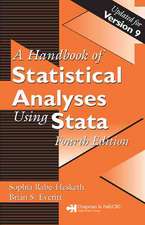Statistics for Censored Environmental Data Using Minitab and R 2e
Autor DR Helselen Limba Engleză Hardback – 19 feb 2012
Preț: 790.92 lei
Preț vechi: 869.15 lei
-9% Nou
Puncte Express: 1186
Preț estimativ în valută:
151.34€ • 158.02$ • 124.97£
151.34€ • 158.02$ • 124.97£
Carte tipărită la comandă
Livrare economică 15-29 aprilie
Preluare comenzi: 021 569.72.76
Specificații
ISBN-13: 9780470479889
ISBN-10: 0470479884
Pagini: 344
Dimensiuni: 156 x 235 x 18 mm
Greutate: 0.61 kg
Ediția:2nd Edition
Editura: Wiley
Locul publicării:Hoboken, United States
ISBN-10: 0470479884
Pagini: 344
Dimensiuni: 156 x 235 x 18 mm
Greutate: 0.61 kg
Ediția:2nd Edition
Editura: Wiley
Locul publicării:Hoboken, United States
Public țintă
As a reference for environmental professionals including biologosts and ecologists in government, consulting firms, and academia who focus on the water sciences, air quality, soil science, environmental chemistry, and environmental health; as a textbook for upper–undergraduate and graduate courses in statistics for the sciences and environmental statistics; academic and corporate libraries.Cuprins
Notă biografică
Dennis R. Helsel, PhD, is owner and Principal Scientist of Practical Stats, where he designs and conducts training courses in environmental statistics for scientists. He has over thirty years of experience working with the U.S. Geological Survey and is the author of numerous published articles on nondetect data and statistical methods in the environmental sciences. Dr. Helsel is the recipient of the Distinguished Service Award from the U.S. Department of the Interior (2007) as well as the Distinguished Achievement Award from the American Statistical Association (2003).
Descriere
This Second Edition solves a current dilemma that occurs across a wide spectrum of environmental science: how to correctly analyze and interpret censored data (data below detection limits). It adapts survival analysis methods and demonstrates their practical applications when studying trace chemicals in air, water, soils, and biota.










